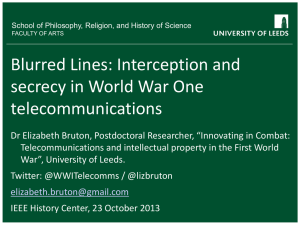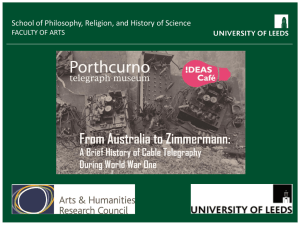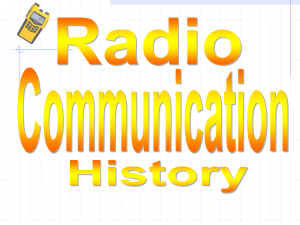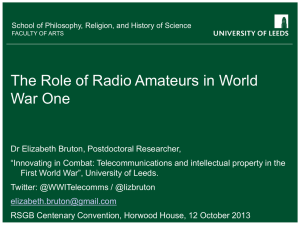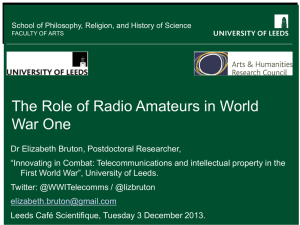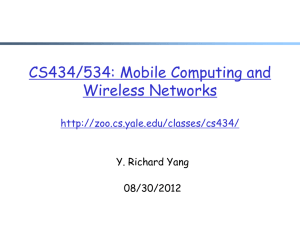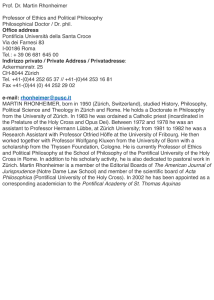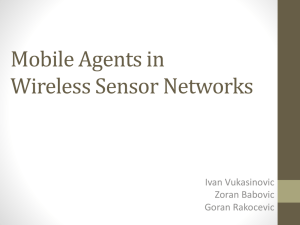PowerPoint slides - MHS Blogs
advertisement
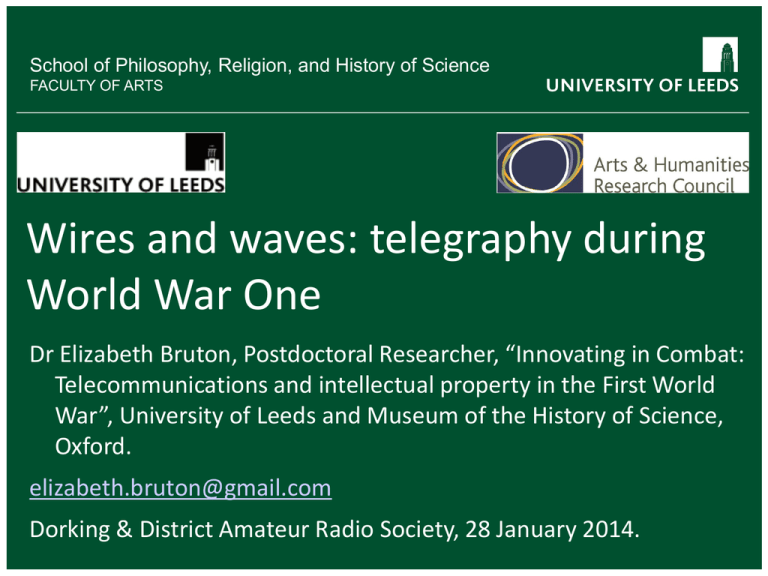
School of Philosophy, Religion, and History of Science FACULTY OF ARTS Wires and waves: telegraphy during World War One Dr Elizabeth Bruton, Postdoctoral Researcher, “Innovating in Combat: Telecommunications and intellectual property in the First World War”, University of Leeds and Museum of the History of Science, Oxford. elizabeth.bruton@gmail.com Dorking & District Amateur Radio Society, 28 January 2014. School of Philosophy, Religion, and History of Science FACULTY OF ARTS Innovating in Combat • Aims: to help museums, archives, and public to better appreciate the significance of communications technologies and patents during World War One • Partners: BT archives, IET archives, Imperial War Museum North, Porthcurno Telegraph Museum, Science Museum, University of Leeds HSTM Museum • University of Leeds and Museum of the History of Science, Oxford • Graeme Gooday and Elizabeth Bruton • Funded by AHRC School of Philosophy, Religion, and History of Science FACULTY OF ARTS Outline • Telecommunications innovations up to WWI • Security and privacy • Interception • Contrasting perspectives of WWI telecommunications • Cable telegraph network • Frontline telephony • Wireless telegraphy • Wireless amateurs & Marconi Company • Conclusions 'Are YOU in this?', courtesy of the Imperial War Museum. © IWM, Art.IWM PST 2712. School of Philosophy, Religion, and History of Science FACULTY OF ARTS Importance of Telecommunications • Communications key feature of warfare - need interconnected combat machinery pigeon, messengers, telegraph etc • Key issues: speed, reliability, & non-interception telephone brings benefit? • Wireless used since Second Boer War (1899-1902) • Symmetrical use of wireless & telephone in RussoJapanese War (1904-5). • Counter-measures taken against security risks: defensive and offensive. • In UK outbreak of war on 4 August 1914 & armistice on 11 November 1918 both announced by wireless signals – Marconi Transcript of wireless message sent from Marconi station at Poldhu on 4 August 1914. Image courtesy of Burton-uponTrent Amateur Radio club. School of Philosophy, Religion, and History of Science FACULTY OF ARTS Cable Telegraphy before World War One 1891 Telegraph Cable map. Image available in public domain. School of Philosophy, Religion, and History of Science FACULTY OF ARTS Telegraphy and “Cable Wars” Left: Segment of Borkum cable. Image courtesy of Porthcurno Telegraph Museum. Right: Map of the action between HMAS Sydney and SMS Emden on 9 November 1914 at the Cocos Islands. Images available in the public domain. School of Philosophy, Religion, and History of Science FACULTY OF ARTS “Cable Wars”: The attack on Cocos Islands The two severed ends of the “dummy” cable after the attack. Image courtesy of Porthcurno Telegraph Museum. School of Philosophy, Religion, and History of Science FACULTY OF ARTS “Cable Wars”: The attack on Cocos Islands The destroyed wireless mast after the attack. Image courtesy of Porthcurno Telegraph Museum. School of Philosophy, Religion, and History of Science FACULTY OF ARTS “Cable Wars”: The attack on Cocos Islands The instrument room on Direction Island, as left by the Germans. Image courtesy of Porthcurno Telegraph Museum. School of Philosophy, Religion, and History of Science FACULTY OF ARTS “Cable Wars”: German attack on British-Norwegian cable, 1915 Left: The message left by the Germans that attacked the Cable. Right: The two ends of the severed cables with the “mysterious apparatus” still attached. Both images courtesy of BT archives. School of Philosophy, Religion, and History of Science FACULTY OF ARTS “Cable Wars”: Zimmermann Telegram Left: The encrypted version of the Zimmermann telegram obtained from Mexican telegraph office. Right: A portion of the Telegram as decrypted ‘Room 40’. Both images are available in the public domain. School of Philosophy, Religion, and History of Science FACULTY OF ARTS Telephones the Trenches ‘In the summer of 1915 the enemy did suddenly appear to be extraordinarily well informed of all that was going on behind our lines. This was manifested in many ways… Carefully planned raids and minor attacks were met by hostile fire, exactly directed, and timed to the minute of the attack. One day, even, a well-known Scotch battalion took over its new front to the strains of its regimental march, exceedingly well played upon a German cornet’ Major R.E. Priestley, The Signal Service in the European War of 1914-18 (France) 1921, pp.98-99 Wills’s cigarette card from 1915 showing Corporal Cyril Bassett, Divisional Signals, New Zealand Engineers, laying telephone lines at Chanuk Bair, Gallipoli on 7 August 1915. Image available in the public domain. School of Philosophy, Religion, and History of Science FACULTY OF ARTS Response: Fullerphone • Developed in 1915 by Major Algernon Clement Fuller • Response (sort of) to problems with frontline telephone communication • Who was Fuller? • Army Wireless Co, Aldershot in 1910: amplification technique of “Dynaphone” • 1915-16: Claimed unaware of the insecurity of trench communications at battlefront • Invented privately in ‘cottage’: technique of chopped up tiny telegraph signals Fuller being awarded the Royal Signals Institution’s Princess Mary medal 1966. Image courtesy of the Royal Signals Institution School of Philosophy, Religion, and History of Science FACULTY OF ARTS Fullerphone • Anti-interception telegraphic device by Major A. Clement Fuller in 1915-16 • Miniscule earth currents of signal transmuted to ‘noise’ - very difficult to intercept. • Claim for telegraphic ‘Fullerphone’ to Royal Commission on Awards to Inventors, 1920 • Claimed £21,899 – but only awarded £3,500, due to limited originality, & patent benefits • Instead made OBE 1922 and CBE 1941, promoted to Major General Fullerphone mark III (1916-1917) with earphones. Image available in the public domain. School of Philosophy, Religion, and History of Science FACULTY OF ARTS Wireless Telegraphy – Marconi Company • Marconi company innovations in wireless point to point communication: 1897 & 1900 • 1914: British Marconi Co. patriotically offers wireless operators & training to services. • Company allowed government ‘censors’ to monitor all wireless communications – codebreakers in Admiralty’s secret ‘Room 40’. • Impact on long-distance wireless stations? • No upfront demand for payment. in summer 1915 Marconi’s General Manager complained “not one penny-piece has yet been refunded to us.” BT Archives POST 30/4162 Marconi Wireless Station, Poldhu, c.1910. Image available in the public domain via Wikimedia Commons School of Philosophy, Religion, and History of Science FACULTY OF ARTS Wireless Telegraphy – Marconi Company Map of routes of Zeppelins made by Marconi direction-finders on English east coast, 1916, Marconi Archives, Bodleian Library, University of Oxford. Image courtesy of Bodleian Library, Oxford. School of Philosophy, Religion, and History of Science FACULTY OF ARTS Marconi Company case for reward? • Key role in intercepting hostile communications, and “direction finders” tracking German navy and airships • Marconi Company entered legal dispute with UK government over unpaid patent royalties in 1920. • Protracted discussions on six-figure royalty claims: devolved to a private adjudication. • Marconi Company: discreet deliberations 1922-8 c.£500,000 • Soon to form Cable & Wireless Temporary wireless direction-finding station on the cliffs of Hunstanton, Norfolk, c.1915 Image from the Marconi archives, Bodleian Library, University of Oxford. School of Philosophy, Religion, and History of Science FACULTY OF ARTS But what could wireless amateurs do during wartime? • “Listen in” – wartime wireless interception and signals intelligence • Russell Clark and Richard Hippisley • Henry Norman MP • Wartime Service • Leslie McMichael Richard John Bayntun Hippisley (1865-1956) Image from Mate's County Series (1908) and available in the public domain. School of Philosophy, Religion, and History of Science FACULTY OF ARTS Hunstanton Wireless Station, Norfolk A postcard of the Lighthouse and Marconi Wireless Station at Hunstanton, early 20th C. Wireless station is to the left of the mast. Image available in the public domain. School of Philosophy, Religion, and History of Science FACULTY OF ARTS Hunstanton Wireless Station, Norfolk Wireless Direction-Finding Station at Hunstanton, early World War One. Image available in the public domain. School of Philosophy, Religion, and History of Science FACULTY OF ARTS Hunstanton Wireless Station, Norfolk Former power station for the Marconi wireless station at Hunstanton as it is today. Image courtesy of RightMove.co.uk. School of Philosophy, Religion, and History of Science FACULTY OF ARTS Henry Norman, MP (1858-1939) • Born in Leicester and educated abroad • MP for 23 years • Knighted in 1906 • Pioneer in radio telegraphy • 1914: First President of Derby Wireless Club, founded in 1911 • “Listening in” begins before outbreak of Portrait of Sir Henry Norman, 1st Baronet, war taken from The World's Work (1914). Image available in the public domain via Wikimedia Commons. School of Philosophy, Religion, and History of Science FACULTY OF ARTS Hubert Leslie McMichael (1884-1951) • Generally known as Leslie McMichael • Background in electrical engineering (and laundry?) • Served in Wireless Instructional Section of RFC and RAF • 1919: Demobbed and begins business in Hampstead, supply ex-military stock including radio valves • June 1920: Establishes L. McMichael Ltd • Directors are Leslie McMichael and Rene Klein Leslie McMichael, callsign G2MI. Image courtesy of RSGB. School of Philosophy, Religion, and History of Science FACULTY OF ARTS Conclusions • Case study of battlefield telecommunications interception as driving technical innovation • Security and practicality: telegraph, telephone, and wireless telegraph • Wartime innovations such as Fullerphone not an immediate nor straightforward response to wartime needs • What were the just rewards of invention: Financial, reputational, decoration? • What place for telecommunications in ` Great War commemorations? “Through” 1917 Francis Martin, Royal Engineers . Image courtesy Royal Signals Museum School of Philosophy, Religion, and History of Science FACULTY OF ARTS Conclusions – not just distant examples • Local example: Lt J W Russell MC DCM MM RE, Dorking • Served on Western Front in Signals Company of Royal Engineers during World War One • Most decorated bell-ringer in Surrey Association during World War One, possibly most decorated bell-ringer in World War One • Subject of guest article on our project website by David Underdown, ` National Archives Peal band at Farnham, 25 May 1910, muffled peal of Bob Major to mark the funeral of King Edward VII that day. Russell is in the doorway at the back of the group. Image courtesy of David Underdown and Surrey Bell Ringers Association. School of Philosophy, Religion, and History of Science FACULTY OF ARTS Thank you! Acknowledgements: Radio Society of Great Britain (RSGB) for permission to use many of the images in this presentation. e: elizabeth.bruton@gmail.com w: http://blogs.mhs.ox.ac.uk/innovatingincombat/ @WWITelecomms / @lizbruton
